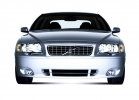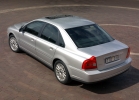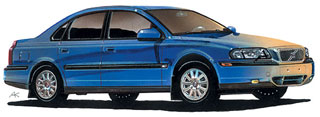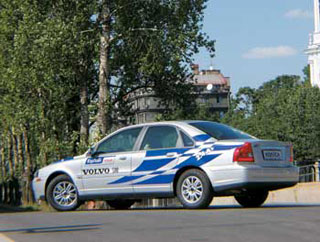Test drive Volvo S80 2003 - 2006 sedan
Wayward volvo
The S80 model received an all -wheel drive transmission, and with it a new character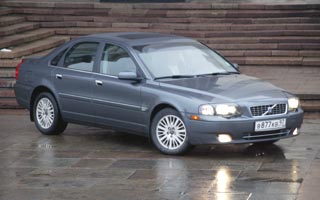 Having passed this summer through light restyling (AI No. 17, 2003), Volvo S80 was younger, became more comfortable and dynamic. The car was not enough unless the AWD branded system, which the Swedes promised to present a little later. Now the promise has been fulfilled, and the car was on the test in AI. Moreover, in the most successful season for familiarization with all delights of all -wheel drive - when under the wheels it is wet asphalt, then snow.
Having passed this summer through light restyling (AI No. 17, 2003), Volvo S80 was younger, became more comfortable and dynamic. The car was not enough unless the AWD branded system, which the Swedes promised to present a little later. Now the promise has been fulfilled, and the car was on the test in AI. Moreover, in the most successful season for familiarization with all delights of all -wheel drive - when under the wheels it is wet asphalt, then snow. Riddles AWD
Full -wheel drive systems in modern cars are, one might say, things in yourself. Firstly, because they differ significantly from each other in design. In some, Viskoft is used, in others a multi -disc clutch, thirdly electromechanical coupling, plus electronic control systems play a large role. Secondly, and this is the most important thing, all-wheel drive cars from different manufacturers and behave on the road completely differently. For a reason, by the way, each system has its own corporate name - QUATTRO, 4MATIC, 4WD, AWD, etc. Therefore, you should know that it is impossible to learn in principle to manage (make a reservation: to manage, own special techniques, and not just drive) an all -wheel drive machine, each requires special skills that are acquired during training, and better under the guidance of a knowledgeable instructor. So, of all the AWD systems from Volvo are the most mysterious, although it has been known for several years according to the Cross Country model.
 The thing is that in the usual traffic modes along dry asphalt 95% torque in the S80 AWD is transmitted to the front wheels. In other words, in this case, we are dealing with the front -wheel drive machine in the full sense of the word. But in certain situations, say, when passing a snowy turn at high speed, the car at the exit of the turn suddenly turns out to be rear -wheel drive. And - trouble, if the driver is not ready for this. The above does not mean that the owner of Volvo AWD is at greater risk, nevertheless, on the contrary. With measured driving, with a normal speed of speed by 10-30 km/h (even traffic cops sometimes forgive this), the car remains absolutely obedient and predictable in reactions. In the turn, an inexperienced person probably does not even feel a change of mood, but simply with confidence in his own skill, will reliably and quickly complete the maneuver. Well, for those who are prone to rapid maneuvers and fast movement, it would not be bad to know the details.
The thing is that in the usual traffic modes along dry asphalt 95% torque in the S80 AWD is transmitted to the front wheels. In other words, in this case, we are dealing with the front -wheel drive machine in the full sense of the word. But in certain situations, say, when passing a snowy turn at high speed, the car at the exit of the turn suddenly turns out to be rear -wheel drive. And - trouble, if the driver is not ready for this. The above does not mean that the owner of Volvo AWD is at greater risk, nevertheless, on the contrary. With measured driving, with a normal speed of speed by 10-30 km/h (even traffic cops sometimes forgive this), the car remains absolutely obedient and predictable in reactions. In the turn, an inexperienced person probably does not even feel a change of mood, but simply with confidence in his own skill, will reliably and quickly complete the maneuver. Well, for those who are prone to rapid maneuvers and fast movement, it would not be bad to know the details.  It is worth on the dry coating to go into a turn, as the behavior of the car changes slightly. The Haldex electromechanical coupling, used in the transmission, throws part of the torque into the rear wheels. According to it, it sets parity between the axes, supplying 50% of the thrust for each. The result is the following: at the entrance to the turn, you control the purebred front -wheel drive machine, which seems to be ready at any time under the discharge of gas, slightly throw the ass. But - no, the next moment the electronic brains work, and - no sliding, all four wheels become leading and provide a given trajectory of movement. The main thing here is not to get carried away. At the same time, the softer compared to competitors-Audi A6, BMW of the 5th series and Mercedes-Benz E-class-the suspension allows the body to roll. Not so much that it scares, but still noticeable. It is understandable: the car was created, including with an sight on the US market, where the rigidity of the chassis is still not in fashion.
It is worth on the dry coating to go into a turn, as the behavior of the car changes slightly. The Haldex electromechanical coupling, used in the transmission, throws part of the torque into the rear wheels. According to it, it sets parity between the axes, supplying 50% of the thrust for each. The result is the following: at the entrance to the turn, you control the purebred front -wheel drive machine, which seems to be ready at any time under the discharge of gas, slightly throw the ass. But - no, the next moment the electronic brains work, and - no sliding, all four wheels become leading and provide a given trajectory of movement. The main thing here is not to get carried away. At the same time, the softer compared to competitors-Audi A6, BMW of the 5th series and Mercedes-Benz E-class-the suspension allows the body to roll. Not so much that it scares, but still noticeable. It is understandable: the car was created, including with an sight on the US market, where the rigidity of the chassis is still not in fashion. However, back to the AWD system. What will happen if you add gas on dry asphalt? S80 simply begins to demolish all four wheels, rather smoothly and predictably. And in the snow?
About the benefits of training
 ... This time, weather forecasters were not mistaken in forecasts. The asphalt platform, on which yesterday it was possible to ride rollers, in an instant turned into a snowy field. This is where I will repeat yesterday's maneuver. I enter the rotation marked by cones with excess speed - from the side it may seem that the driver is preparing for a crash test. (By the way, in real road conditions, I almost watch maneuvers and worse all day). The machine behaves confidently, the tires gain constant contact with the snow, that is, the all -wheel drive managed to distribute the torque between the axes, giving a large from its parts to the front wheels. Now the turn of the steering wheel. Speed \u200b\u200b- about 60 km/h. Volvo begins to slightly demolish the turn of the front. Gas reset: in theory, now the tires should get contact with the road, and the feed is slightly shifted. So it would have happened on the front -wheel drive S80. In our case, the actions of a person sitting at the wheel coincided with the work of the coupling in the transmission. The car almost instantly became all -wheel drive and calmly entered the turn.
... This time, weather forecasters were not mistaken in forecasts. The asphalt platform, on which yesterday it was possible to ride rollers, in an instant turned into a snowy field. This is where I will repeat yesterday's maneuver. I enter the rotation marked by cones with excess speed - from the side it may seem that the driver is preparing for a crash test. (By the way, in real road conditions, I almost watch maneuvers and worse all day). The machine behaves confidently, the tires gain constant contact with the snow, that is, the all -wheel drive managed to distribute the torque between the axes, giving a large from its parts to the front wheels. Now the turn of the steering wheel. Speed \u200b\u200b- about 60 km/h. Volvo begins to slightly demolish the turn of the front. Gas reset: in theory, now the tires should get contact with the road, and the feed is slightly shifted. So it would have happened on the front -wheel drive S80. In our case, the actions of a person sitting at the wheel coincided with the work of the coupling in the transmission. The car almost instantly became all -wheel drive and calmly entered the turn. 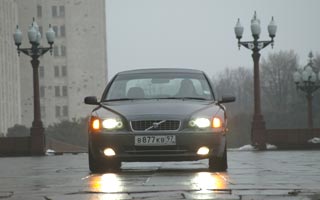 And if even more gas? To the question why?, Who can involuntarily arise, I will answer this way: a driver who has persistent front -wheel drive skills, would have done just that when demolishing the rear wheels. So, the accelerator pedal is almost pressed to the floor, and I repeat the maneuver - I go into a turn with a noticeable excess speed. At first, everything happens as described above. But - what is it? - Feed suddenly begins to overtake the front line and turns me 180 degrees. This is how the peculiarity of Volvo all -wheel drive transmission was manifested: in contrast to the same Mercedes 4Matic, which limits the transfer of traction within 20% (60/40 or vice versa), it varies the distribution of torque within a wider limits - up to 95% of the torque can be supplied, in Depending on the situation, on the front or rear axle. In parallel, the role of differential locks is played by the electronic stabilization system. In my case, with a turn, the artificial brain of the car considered that the rear wheels have the best clutch with the road, and threw almost all the thrust on them. How to deal with this? If you get used to it, then, in general, it is not difficult. In a critical situation, as if in the rear -wheel drive machine, it is necessary to slightly reduce gas supply, but to work with the pedal very carefully. Then the coupling will again transfer the torque again equally equally between the axes and you will at least restore control over the car. Well, and it will not be superfluous to call in the first snow on the suitable platform and turn the car for an hour or two. Exclusively in order to get used to his behavior.
And if even more gas? To the question why?, Who can involuntarily arise, I will answer this way: a driver who has persistent front -wheel drive skills, would have done just that when demolishing the rear wheels. So, the accelerator pedal is almost pressed to the floor, and I repeat the maneuver - I go into a turn with a noticeable excess speed. At first, everything happens as described above. But - what is it? - Feed suddenly begins to overtake the front line and turns me 180 degrees. This is how the peculiarity of Volvo all -wheel drive transmission was manifested: in contrast to the same Mercedes 4Matic, which limits the transfer of traction within 20% (60/40 or vice versa), it varies the distribution of torque within a wider limits - up to 95% of the torque can be supplied, in Depending on the situation, on the front or rear axle. In parallel, the role of differential locks is played by the electronic stabilization system. In my case, with a turn, the artificial brain of the car considered that the rear wheels have the best clutch with the road, and threw almost all the thrust on them. How to deal with this? If you get used to it, then, in general, it is not difficult. In a critical situation, as if in the rear -wheel drive machine, it is necessary to slightly reduce gas supply, but to work with the pedal very carefully. Then the coupling will again transfer the torque again equally equally between the axes and you will at least restore control over the car. Well, and it will not be superfluous to call in the first snow on the suitable platform and turn the car for an hour or two. Exclusively in order to get used to his behavior. A strange pattern
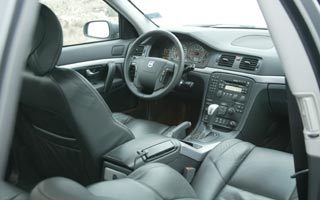 I admit, I managed to ride many Volvo. Those old cars, who did not represent anything special, and models of a new wave, which have become more combed in terms of controllability and dynamics. But one sensation did not leave me for a minute. You get inside, and at first it seems that you have not seen more conveniently a car in your life. Traditionally soft chairs, upholstered in thick, but surprisingly delicate skin, chubby steering wheel, a clear combination of devices, a very high-quality radio, to which you can order a TV tuner and a monitor advanced from the front panel. You sit and enjoy comfort. These feelings prevail during the first few hours of communication with any, I repeat, Volvo. But in the process of using the machine, small miscalculations in ergonomics come to the surface. There are few of them, but they are. Firstly, the steering wheel switch of turns. It also has a ring that changes information on the on -board computer display. For example, I prefer to always keep a hint in front of my eyes about how many kilometers I can still drive at the fuel that remained in the tank. So, indicating the turn, I willy-nilly constantly touched the ring and changed the readings on the screen. It is not too convenient, because then you have to be distracted from the road and restore the necessary information.
I admit, I managed to ride many Volvo. Those old cars, who did not represent anything special, and models of a new wave, which have become more combed in terms of controllability and dynamics. But one sensation did not leave me for a minute. You get inside, and at first it seems that you have not seen more conveniently a car in your life. Traditionally soft chairs, upholstered in thick, but surprisingly delicate skin, chubby steering wheel, a clear combination of devices, a very high-quality radio, to which you can order a TV tuner and a monitor advanced from the front panel. You sit and enjoy comfort. These feelings prevail during the first few hours of communication with any, I repeat, Volvo. But in the process of using the machine, small miscalculations in ergonomics come to the surface. There are few of them, but they are. Firstly, the steering wheel switch of turns. It also has a ring that changes information on the on -board computer display. For example, I prefer to always keep a hint in front of my eyes about how many kilometers I can still drive at the fuel that remained in the tank. So, indicating the turn, I willy-nilly constantly touched the ring and changed the readings on the screen. It is not too convenient, because then you have to be distracted from the road and restore the necessary information.  The second complaint is the traction control process. More precisely, the compatibility of the engine is 2.5t with a five -speed automatic. In the movement, they do not cause any complaints, but at the start or in a sluggish traffic jam, I hardly managed to maintain smooth movement. The fact is that the S80 motor is equipped with a low -pressure turbine, which begins to breathe in full breast from about 1300 rpm. Good indicator. But idle turns are kept at 600 rpm, and while the tachometer arrow does not overcome the gap, the thrust is frankly small. But then she suddenly appears. Moreover, in such quantities that it is difficult to avoid a jerk. Personally, I would prefer more smooth reactions.
The second complaint is the traction control process. More precisely, the compatibility of the engine is 2.5t with a five -speed automatic. In the movement, they do not cause any complaints, but at the start or in a sluggish traffic jam, I hardly managed to maintain smooth movement. The fact is that the S80 motor is equipped with a low -pressure turbine, which begins to breathe in full breast from about 1300 rpm. Good indicator. But idle turns are kept at 600 rpm, and while the tachometer arrow does not overcome the gap, the thrust is frankly small. But then she suddenly appears. Moreover, in such quantities that it is difficult to avoid a jerk. Personally, I would prefer more smooth reactions. Here, perhaps, is all the shortcomings that I noticed in the S80. It remains only to tell that the all-wheel drive version is available only with the most powerful 210-horsepower in the range. Cost - from 38,500 euros. Warranty - two years or 100,000 km of run, interval interval - 15,000 km.
Sergey Ilyinsky
Brief technical characteristics of Volvo S80 AWD
Engine volume, cubic meter. See: 2521
The number of valves for the cylinder: 4
Power, l. With. at about./min.: 210/5000
Max. Torque, Nm/at about. min.: 320/1800-4500
Acceleration to 100 km/h, p.: 8.5
Maximum speed, km/h: 225
Average fuel consumption l./100 km.: 10.2
Fuel tank volume, l.: 80
Dimensions, mm.: 4822x1832x1434



